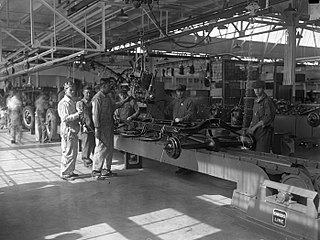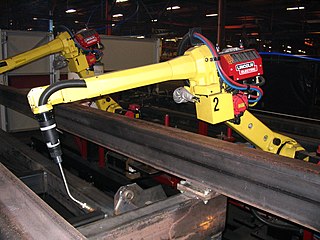
An industrial robot is a robot system used for manufacturing. Industrial robots are automated, programmable and capable of movement on three or more axes.

Motion capture is the process of recording the movement of objects or people. It is used in military, entertainment, sports, medical applications, and for validation of computer vision and robots. In films, television shows and video games, motion capture refers to recording actions of human actors and using that information to animate digital character models in 2D or 3D computer animation. When it includes face and fingers or captures subtle expressions, it is often referred to as performance capture. In many fields, motion capture is sometimes called motion tracking, but in filmmaking and games, motion tracking usually refers more to match moving.
Therbligs are elemental motions used in the study of workplace motion economy. A workplace task is analyzed by recording each of the therblig units for a process, with the results used for optimization of manual labour by eliminating unneeded movements. Eighteen therbligs have been defined.

A time and motion study is a business efficiency technique combining the Time Study work of Frederick Winslow Taylor with the Motion Study work of Frank and Lillian Gilbreth. It is a major part of scientific management (Taylorism). After its first introduction, time study developed in the direction of establishing standard times, while motion study evolved into a technique for improving work methods. The two techniques became integrated and refined into a widely accepted method applicable to the improvement and upgrading of work systems. This integrated approach to work system improvement is known as methods engineering and it is applied today to industrial as well as service organizations, including banks, schools and hospitals.
Maynard operation sequence technique (MOST) is a predetermined motion time system that is used primarily in industrial settings to set the standard time in which a worker should perform a task. To calculate this, a task is broken down into individual motion elements, and each is assigned a numerical time value in units known as time measurement units, or TMUs, where 100,000 TMUs is equivalent to one hour. All the motion element times are then added together and any allowances are added, and the result is the standard time. It is more common in Asia whereas the original and more sophisticated Methods Time Measurement technique, better known as MTM, is a global standard.
A predetermined motion time system (PMTS) is frequently used to perform labor minute costing in order to set piece-rates, wage-rates or incentives in labor oriented industries by quantifying the amount of time required to perform specific tasks under defined conditions. Today the PMTS is mainly used in work measurement for shorter cycles in labour oriented industries such as apparel and footwear. This topic comes under wider industrial and production engineering. One of such a system is known as "work factor" and more popular methods-time measurement (MTM), released in 1948 exist today in several variations and used in some commercial applications.

Operations management is concerned with designing and controlling the production of goods and services, ensuring that businesses are efficient in using resources to meet customer requirements.

An articulated robot is a robot with rotary joints that has 6 or more Degrees of Freedom. This is one of the most commonly used robots in industry today. Articulated robots can range from simple 6 Degree of Freedom structures to systems with 10 or more interacting joints and materials. They are powered by a variety of means, including electric motors.
In industrial engineering, the standard time is the time required by an average skilled operator, working at a normal pace, to perform a specified task using a prescribed method. It includes appropriate allowances to allow the person to recover from fatigue and, where necessary, an additional allowance to cover contingent elements which may occur but have not been observed.
Design for assembly (DFA) is a process by which products are designed with ease of assembly in mind. If a product contains fewer parts it will take less time to assemble, thereby reducing assembly costs. In addition, if the parts are provided with features which make it easier to grasp, move, orient and insert them, this will also reduce assembly time and assembly costs. The reduction of the number of parts in an assembly has the added benefit of generally reducing the total cost of parts in the assembly. This is usually where the major cost benefits of the application of design for assembly occur.
The International MTM Directorate (IMD) is a Federation of National Methods-Time Measurement Associations. It was originally constituted in Paris on June 25, 1957, and was then reincorporated under the laws of Ohio on November 6, 1968. Membership in the International MTM Directorate is held by National associations acknowledged by IMD as representing MTM activities in their respective countries.
The Air Movement and Control Association International, Inc. (AMCA) is an American trade body that sets standards for Heating, Ventilation and Air Conditioning (HVAC) equipment. It rates fan balance and vibration, aerodynamic performance, air density, speed and efficiency.
Work measurement is the application of techniques which is designed to establish the time for an average worker to carry out a specified manufacturing task at a defined level of performance. It is concerned with the duration of time it takes to complete a work task assigned to a specific job. It means the time taken to complete one unit of work or operation it also that the work should completely complete in a complete basis under certain circumstances which take into account of accountants time

Robotics is the branch of technology that deals with the design, construction, operation, structural disposition, manufacture and application of robots. Robotics is related to the sciences of electronics, engineering, mechanics, and software.

Industrial engineering is an engineering profession that is concerned with the optimization of complex processes, systems, or organizations by developing, improving and implementing integrated systems of people, money, knowledge, information and equipment. Industrial engineering is central to manufacturing operations.
Work sampling is the statistical technique used for determining the proportion of time spent by workers in various defined categories of activity. It is as important as all other statistical techniques because it permits quick analysis, recognition, and enhancement of job responsibilities, tasks, performance competencies, and organizational work flows. Other names used for it are 'activity sampling', 'occurrence sampling', and 'ratio delay study'.

Ergonomics, also known as human factors or human factors engineering (HFE), is the application of psychological and physiological principles to the engineering and design of products, processes, and systems. Primary goals of human factors engineering are to reduce human error, increase productivity and system availability, and enhance safety, health and comfort with a specific focus on the interaction between the human and equipment.
Industrial and production engineering (IPE) is an interdisciplinary engineering discipline that includes manufacturing technology, engineering sciences, management science, and optimization of complex processes, systems, or organizations. It is concerned with the understanding and application of engineering procedures in manufacturing processes and production methods. Industrial engineering dates back all the way to the industrial revolution, initiated in 1700s by Sir Adam Smith, Henry Ford, Eli Whitney, Frank Gilbreth and Lilian Gilbreth, Henry Gantt, F.W. Taylor, etc. After the 1970s, industrial and production engineering developed worldwide and started to widely use automation and robotics. Industrial and production engineering includes three areas: Mechanical engineering, industrial engineering, and management science.

Harold Bright Maynard was an American industrial engineer, consulting engineer at the Methods Engineering Council, and management author. He is known as the "Broadway counsel for industries, railroads, state governments" and as recipient of the Henry Laurence Gantt Medal in 1964.








